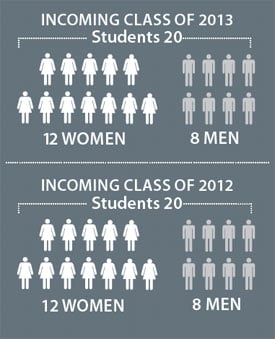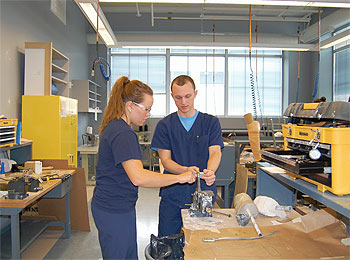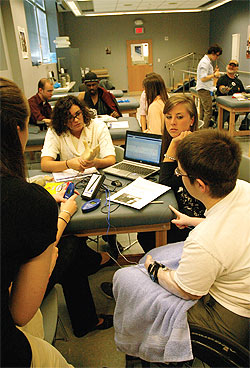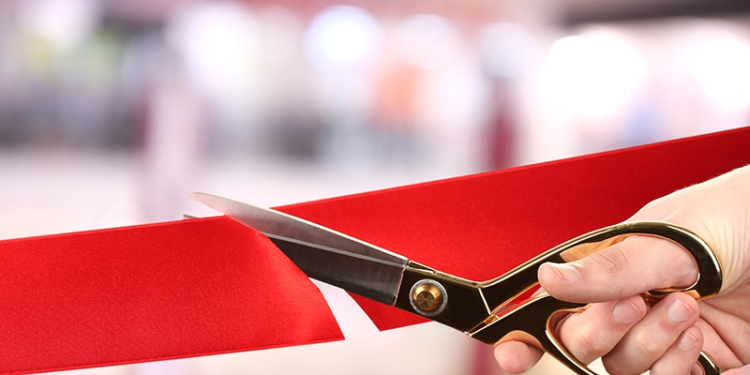The O&P EDGE continues its series of National Commission on Orthotic and Prosthetic Education (NCOPE)-accredited master’s level O&P educational programs.
This month we feature the University of Pittsburgh, School of Health and Rehabilitation Sciences, Master of Science in Prosthetics and Orthotics (MSPO) program.
Background

The impetus for developing the MSPO program at the University of Pittsburgh (Pitt), Pennsylvania, came in large part from Ray Burdett, PhD, PT, CO, CPed. Aside from his work developing the 20-month, five-term program, which saw its first incoming class in 2009, Burdett was an instructor and program director until his retirement in December 2012. Burdett and current instructor and program coordinator Sara Peterson, MBA, CPO, CFm, FAAOP, were the first faculty of the MSPO program. Peterson now shares instruction responsibilities with two other full-time faculty members, a part-time adjunct instructor, and a full-time technician who teaches the fabrication elements of the program.
Program
The MSPO program is under the auspice of the Department of Rehabilitation Science and Technology (RST), and offers students the benefit of Pitt’s Human Engineering Research Laboratories (HERL), which are part of the U.S. Department of Veterans Affairs (VA) Pittsburgh Healthcare System, and directed by Rory Cooper, PhD, the RST chair. HERL and the MSPO program are neighbors in an off-campus building; the MSPO program has 5,000-square-feet of classroom and lab space and access to HERL resources, including one of just a few computer-assisted rehabilitation environment (CAREN) systems in the nation. CAREN allows MSPO students to adjust terrain in virtual reality so they can observe patients’ gait on surfaces of varying firmness and consistency. The MSPO program also has access to a gait lab through Pitt’s Department of Physical Therapy.

Students bend metal to fabricate an AFO. Photographs courtesy of the University of Pittsburgh.
Students
Most applicants to Pitt’s MSPO program have a background in kinesiology, biology, or engineering. The courses in the program’s first-year fall and spring terms provide the educational foundation and prepare students for the 400 hours in clinical rotations that they begin in the summer term. “We found that it works out better for [the students] to start in summer, so they have… O&P classes under their belt before they started into a clinical setting,” says Peterson. Like other MSPO programs, applicants are encouraged to have volunteer or work experience in an O&P setting-250 hours in Pitt’s case. However, if an applicant fails to meet that recommendation but has an otherwise strong application, he or she may still be accepted. “If they possess the desire and attitude for the field, that can persuade us into choosing them,” says Peterson.

Students work with a patient model in the MYOBOCK myoelectric arm course.
Once they’re accepted, students are in O&P-specific courses for eight hours each weekday. Two weeknights are also dedicated to coursework in broader topics, such as ethics and health-related professions, individual and social experience of disability, issues in the health system, and fundamentals of rehabilitation engineering and technology. This coursework supports RST’s mission to “balance the career needs of our students with the theoretical foundations of the field,” according to its website. Or as Peterson describes it, “We look at all aspects of disability…so [the students] understand the big picture. I think our program is unique because we have these additional classes that we can [teach] outside of orthotics and prosthetics….”
As part of their graduation requirements, students can choose between a non-thesis option that requires writing a “scholarly paper” under the direction of two faculty members, which can be done individually or as a group project, or they can complete an individual master’s thesis under the direction of a faculty advisor and the thesis committee. Peterson says that those students who are particularly interested in research aspects of the profession are more likely to choose the thesis option. Either way, she says, “students will realize how important research is…and can promote outcomes-based research as practitioners.”
Aside from their final papers, students also complete a 200-question comprehensive exam and then undergo a full day of hands-on testing. The hands-on portion of the test involves eight stations at which each student has 15 minutes to complete a task. For example, a prosthetic station requires bench alignment of a transtibial prosthesis; at a gait analysis station, students must identify gait deviations and the indicated conditions, and then define the course of treatment. At Peterson’s orthotic station, students must draw trim lines for metal and plastic KAFOs, a solid ankle AFO, a posterior spring AFO, and a floor-reaction AFO. “We try to have a mock ABC [American Board for Certification in Orthotics, Prosthetics & Pedorthics] exam…. That way we know that the student has comprehended the concepts, has the ability to problem solve, and can provide a spontaneous, rational answer,” she says.
Editor’s note: Articles in this series do not constitute an endorsement or recommendation of any program. Programs will be covered in an order determined by the editor, and all NCOPE-accredited O&P master’s degree programs will be given the opportunity to be featured.




